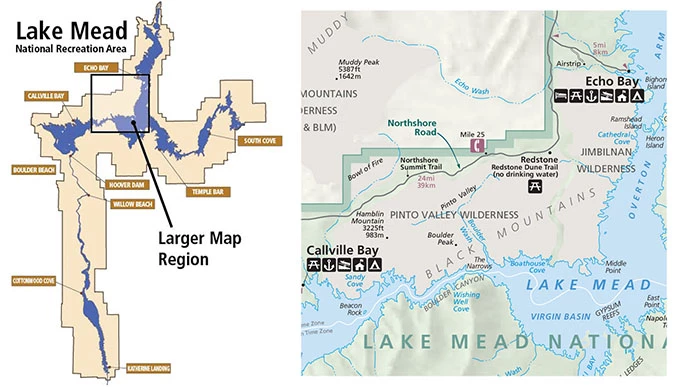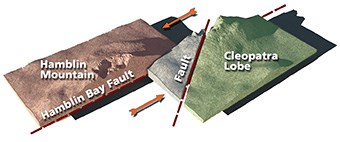
Along the north shore of Lake Mead exists an ancient volcano, long dormant but very intriguing. The Hamblin-Cleopatra Volcano (HCV) was once a large stratovolcano and now has split into three large sections due to earthquake faults in the area. The volcano formed in the late Miocene time and through the years slowly split in half, and then parts of the Cleopatra section split again, separating the original volcano complex by twelve miles. The original volcano was more than 3,000 feet high and had a circular width of approximately eight miles. It’s formation was rapid. Area Map
What is a Stratovolcano
Illustration by Anthony Ross History of Hamblin-Cleopatra
13 Million Years AgoAround 13 million years ago, Hamblin-Cleopatra were one large stratovolcano. The volcano sat on the Hamblin Bay Fault which ran right through the middle of the mountain, splitting it in two. For clarity the Hamblin Mountain portion is in light red, the Cleopatra portion in light green, and the Cleopatra split-off is colored grey..
~1 Million Years AgoOver the millions of years since the volcano has been active the movement of the Hamblin Bay Fault moved the Hamblin portion to the southwest and the Cleopatra terrain to the northeast. Another fault formed that split the Cleopatra lobe in two.
TodayCurrently the Cleopatra lobe is around 12 miles from the Hamblin Mountain lobe. You can see in the color coded USGS map below the distinct locations of the three parts of the Hamblin-Cleopatra Volcano as it is today (Dark Magenta color)
Courtesy of USGS ReferencesGeologic Map by United States Geological Survey https://ngmdb.usgs.gov/Prodesc/proddesc_81106.htm DOI Paper, Large-Magnitude Late Tertiary Strike-Slip Faulting North Lake Mead, R Ernest Anderson. 1973 |
Last updated: December 14, 2022
